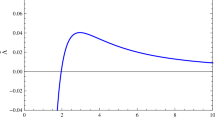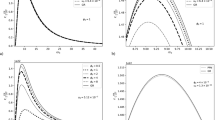Abstract
Spacetime around an accreting black hole is an interesting issue to study. The metric of an isolated black hole (rotating or non-rotating) spacetime has been well-known for decades. Although metrics of some spacetimes containing accreting black holes are known in some situations, the issue has some faces that are not well-known yet and need further investigation. In this paper, we construct a new form of metric which the effect of accretion disk on black hole spacetime is taken into account in the equatorial plane. We study motion and trajectories of massive particles and also photons falling from infinity towards black hole in equatorial plane around the black hole. We use an exponential form for the density profile of the accretion disk in equatorial plane as \(\rho =\rho_{0}e^{-\alpha r}\). We show that with this density profile, the disk is radially stable if \(\alpha \leq 3 \times 10^{-3}\) (in units of length inverse). In order to study some important quantities related to the accretion disks such as locations of marginally stable circular orbits (\(r_{ms}\) or \(r_{\mathit{ISCO}}\)), marginally bounded circular orbits \((r_{mb})\), and also photon orbits in equatorial plane, we use the effective potential approach. We show that in this spacetime metric the innermost stable circular orbit in equatorial plane is given by \(r_{\mathit{ISCO}}=4.03 \mu \) (where \(\mu =\frac{MG}{c ^{2}}\)) which is different, but comparable, with the Schwarzschild spacetime result, \(r^{(Sch)}_{\mathit{ISCO}}=6 \mu \). We show that the maximum radiation efficiency of the accretion disk, \(\eta \), in equatorial plane is 8.6 percent which is greater than the corresponding value for Schwarzschild spacetime. Finally, we show that in this setup photons can have stable circular orbits in equatorial plane unlike the Schwarzschild spacetime.












Similar content being viewed by others
References
Abramowicz, M.A., Calvani, M.: Mon. Not. R. Astron. Soc. 189, 621–626 (1979)
Bardeen, J.M., Press, W.H., Teukolsky, S.A.: Astrophys. J. 178, 347 (1972)
Blaschke, M., Stuchlik, Z.: Phys. Rev. D 94, 6006 (2016)
Calvani, M.: Nuovo Cimento A, Ser. 11 58(4), 364 (1980)
Favata, M.: Phys. Rev. D 83, 024028 (2011)
Frolov, V.P., Shoom, A.A., Tzounis, C.: Phys. Rev. D 90, 4027 (2014)
Hobson, M.P., Efstathiou, G.P., Lasenby, A.N.: General Relativity: An Introduction for Physicists, pp. 205–221. Cambridge University Press, New York (2006)
Johannsen, T.: Phys. Rev. D 87, 4010 (2013)
Johannsen, T., Psaltis, D.: Phys. Rev. D 83, 124015 (2011)
Johnson, B.M., Gammie, C.F.: Astrophys. J. 597, 131 (2003)
Kaplan, S.A.: JETP Lett. 19, 951 (1949)
Kato, S., Fukue, J., Mineshige, S.: Black Hole Accretion Disks: Towards a New Paradigm, pp. 166–175. Kyoto University Press, Kyoto (2008)
Novikov, I.D., Thorne, K.S.: In: DeWitt, C., DeWitt, B.S. (eds.) Black Holes, vol. 343. Gordon & Breach, New York (1973)
Piotrovich, M.Y., Gnedin, Y.N., Silant’ev, N.A., Natsvlishvili, T.M., Buliga, S.D.: Astron. Nachr. 336, 1013 (2015)
Ruffini, R., Wheeler, J.: Cosmology from space platform. In: Proceedings of the Conference on Space Physics. ESRO, Paris (1971)
Shakura, N.I., Sunyaev, R.A.: Astron. Astrophys. 24, 337 (SS73) (1973)
Tanaka, T., Mino, Y., Sasaki, M., Shibata, M.: Phys. Rev. D 54, 3762 (1996)
Tod, K.P., de Felice, F., Calvani, M.: Il Nuovo Cimento B 34, 365 (1996)
Tsupko, O.Yu., Bisnovatyi-Kogan, G.S., Jefremov, P.I.: Gravit. Cosmol. 22, 138 (2016)
Tursunov, A., Stuchlik, Z., Kolos, M.: Phys. Rev. D 93, 4012 (2016)
Xie, F.-G., Yuan, F.: Mon. Not. R. Astron. Soc. 427, 1580 (2012)
Acknowledgements
We would like to thank an anonymous referee for very insightful comments that improved the quality of the paper considerably. The work of K. Nozari has been supported financially by Center for Excellence in Astronomy and Astrophysics of IRAN (CEAAI-RIAAM) under research project No. 1/4717-124.
Author information
Authors and Affiliations
Corresponding author
Rights and permissions
About this article
Cite this article
Salahshoor, K., Nozari, K. & Khesali, A.R. More on accreting black hole spacetime in equatorial plane. Astrophys Space Sci 362, 24 (2017). https://doi.org/10.1007/s10509-016-3004-9
Received:
Accepted:
Published:
DOI: https://doi.org/10.1007/s10509-016-3004-9




